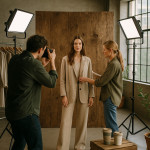Mood boards that help portrait photographers translate abstract brand feeling
A well-crafted mood board turns vague words like “confident but approachable” into concrete visual cues a portrait photographer can shoot. In this guide you'll learn why mood boards matter, which elements to include, and a proven workflow that aligns creative teams and clients before anyone presses the shutter.
Why mood boards are vital for brand-aligned portrait sessions

Brands rarely brief photographers with a crystal-clear visual script. Instead, they gift you adjectives—“edgy”, “warm”, “timeless”. Without a shared reference, those words invite mismatched expectations, costly reshoots and diluted brand storytelling. A mood board bridges that gap by converting abstract feeling into:
- Consistent colour direction that echoes the logo palette.
- Lighting references that establish atmosphere—soft and inviting or high-contrast and dramatic.
- Posing language that mirrors the personality traits the brand wants to broadcast.
According to a 2023 CMI survey, teams using visual references during pre-production cut revision cycles by 30 %. That time saving alone justifies a fifteen-minute board build.
The psychology of visual consensus
Humans process images 60 000 times faster than text. Showing the marketing lead a reference portrait triggers an immediate gut reaction—yay or nay—while written descriptions invite interpretation. Mood boards therefore prevent the “I thought you meant softer shadows” feedback spiral.
Pre-production alignment unlocks smoother shoot days
Once everyone signs off on style, location and palette, a portrait session flows. Crew members arrive knowing the vibe. The client relaxes because they've seen the intention, not just read it. Explore practical alignment tactics in this deep dive on collaborative mood-board tools.
Core components of an effective portrait mood board
1. Colour & Lighting palette
Map brand hues next to lighting references. If the brand uses muted Earth tones, include portraits lit with warm, low-contrast setups. High-key light would contradict the palette—and the feeling.
2. Composition & posing cues
Include two or three framing examples—tight headshot, three-quarter, environmental. Add stick-figure overlays or arrows pointing to posture details, so team members notice exact weight distribution and eye line.
3. Wardrobe & prop guidelines
Photographers aren't stylists, yet the camera records every fabric fold. Show reference outfits that reinforce brand identity. A fintech start-up may opt for rolled sleeves and minimal accessories while a heritage winery might request tweed blazers and handcrafted glassware.
4. Texture & post-production notes
Include swatches of grain level, skin retouching intensity and colour grading LUTs. This ensures the editor matches your anticipated finish, protecting brand consistency across campaigns.
Step-by-step workflow to build a brand-driven mood board
Step 1 – Extract brand values
Interview the client. Ask, “If your brand were a person, how would they introduce themselves at a party?” Note adjectives, cultural references, even music genres—they all inform visual tone.
Step 2 – Curate reference imagery
Pull from your own archive, magazines, and royalty-free libraries. Keep copyright clear so you can share the board internally without legal headaches.
Step 3 – Annotate with intent
A mood board isn't a Pinterest dump. Use arrows, colour swatches and short captions (“soft rim light at 45°”, “neutral greige backdrop”) so every image earns its place.
Step 4 – Validate with the client early
Host a ten-minute video call to walk through the board. Live discussion surfaces contradictions—“We love the light but need more diversity in age representation”—before shoot day expenses rack up.
Step 5 – Share a locked board with crew
Upload the approved PDF or web link to your project management tool. Assistants, retouchers and stylists now have one source of truth.
Digital platforms that accelerate mood-board collaboration
Traditional PDFs still work, yet interactive tools boost clarity and speed.
| Tool | Stand-out feature | Best for |
|---|---|---|
| Figma | Live cursor co-editing | Agile brand teams |
| Milanote | Drag-and-drop columns | Linear shoot timelines |
| Capture One Live | In-session approvals | Remote art directors |
If you often shoot with clients abroad, pair a digital board with the tethering workflow explained in this guide to remote-directed portrait sessions.
Case study: From abstract words to on-brand portraits
Brief: A health-tech start-up described its desired look as “approachable innovation”.
- Values decoded – approachable → soft light; innovation → pops of electric blue.
- Mood board built – neutral studio backdrop, eye-level camera, subtle cyan accent gels.
- Client sign-off – board shared, feedback requested within 24 h.
- Production – lighting diagram attached to board; wardrobe pulled slim-fit casual.
- Result – final portraits matched the board; client approved first proofs with zero edits.
The project later featured on the portrait photographers directory, generating three new enquiries within a week.
Common pitfalls and how to avoid them
- Overcrowded boards – limit to 12 images; abundance breeds confusion.
- Ignoring diversity – represent varied skin tones and body types to future-proof briefs.
- Mismatch between props and brand values – sleek SaaS firms rarely vibe with vintage suitcases.
- Leaving retouching unspoken – show grain level and skin finish upfront.
For a broader style vocabulary, skim this style guide to portrait genres and brand alignment.
FAQ
- How many images should a mood board include?
- Between eight and twelve well-annotated visuals keep focus while covering palette, lighting, pose and grade.
- When in the project timeline should I present the board?
- Share it before scheduling the shoot. Clients who approve a mood board are less likely to request costly last-minute changes.
- Do I need client sign-off in writing?
- Yes. A simple email confirmation or a signature field inside your project hub protects everyone.
- Can mood boards replace detailed call sheets?
- No. Mood boards inspire; call sheets organise logistics. Use both.
- Which file format is safest for sharing externally?
- A flattened PDF prevents accidental image swaps and keeps colour references intact across devices.
Quick quiz: Are your mood boards on point?
Next steps
Need to refine your client-facing profile before sharing boards? Review our optimisation checklist for photographer directories. Then craft a sample board and add it to your pitch deck—visual proof you think strategically, not just aesthetically.
Ready to elevate your portrait commissions? Start building a branded mood board today and watch client approvals move from “maybe” to “signed”.











